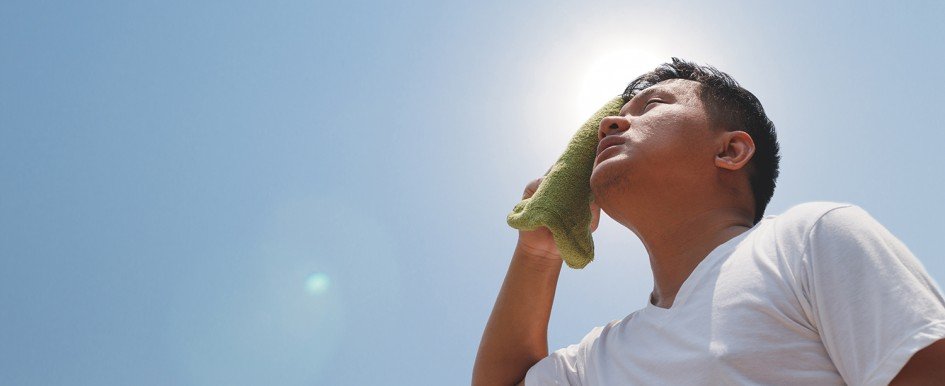
As many of us sit in air-conditioned offices and homes, it’s easy to forget that some workers have no choice but to work outside in the elements, whether it be rain, snow or severely hot temperatures. In 2015, 280 construction workers fell ill due to heat, according to the Bureau of Labor Statistics. Between the hot temperatures and extra layers of protective clothing, it’s important construction workers and their bosses are aware of heat safety.
So, what can employers do to ensure they are protecting their employees from the heat? Below are three tips to mitigate the effects of heat and prevent heat-related illnesses and death.
1. Know & Understand the Signs of Heat-Related Illness
No matter how careful you are, a worker may still experience a heat-related illness, such as heat stroke, heat exhaustion, heat cramps or heat rash, so it’s important to understand the signs and symptoms. The most severe of these conditions, heat stroke, is characterized by:
- Confusion
- Fainting
- Seizures
- Excessive sweating or red, hot and dry skin
- Very high body temperature
It’s important to call 911 at the earliest sign of symptoms, as heat stroke can lead to death if the person’s temperature doesn’t drop back down to a normal range quickly. As you wait for help to arrive, place the worker in a cool, shaded area, provide water, remove outer clothing, and apply ice or cool compresses if available, especially to the worker’s armpits.
Heat exhaustion is characterized by:
- Cool, moist skin
- Heavy sweating
- Headache
- Nausea or vomiting
- Dizziness
- Lightheadedness
- Weakness
- Thirst
- Irritability
- Fast heartbeat
If heat exhaustion is suspected, give the worker plenty of water, have him/her take a break in the shade or air conditioning (if available) and be sure to take him/her to a hospital if symptoms don’t improve after 60 minutes. The worker shouldn’t return to work that day.
Muscle spasms and pain in the worker’s abdomen, arms or legs are signs of heat cramps. Let the worker take a break and drink plenty of water. He/she should be able to return to work a few hours later if the pain subsides. If not, he/she should visit a hospital.
Lastly, clusters of red bumps on the neck and upper chest are signs of heat rash. The worker should keep the rash dry and try to work in a cooler environment.
Symptoms should never be taken lightly. If a worker begins to complain, make sure he/she is treated as quickly as possible. It could mean the difference between life and death.
2. Create a Response Plan & Train Employees on It Regularly
Twenty-eight states throughout the United States have Occupational Safety and Health Administration (OSHA)-approved state plans in place to protect workers from work-related deaths and illnesses. Be sure your company is in compliance by creating a response plan that outlines every step workers should take in the event of a heat-related illness.
At the first sign of symptoms, all employees on the jobsite should know how to react properly. The plan should outline every step workers should take in the event of a heat-related illness. It should also answer all “what if” questions:
- What to do if a worker faints?
- Who should go with the worker if he/she needs to go to hospital?
- Who should call his/her emergency contact?
- Who should take his/her work over until he/she is able to return?
In emergencies, it’s easy for people to panic and not know what to do. By introducing this plan and thoroughly reviewing it when each worker is hired, and then scheduling required training drills throughout the year, every worker should know what to do in the event someone on the jobsite falls ill.
3. Educate Employees on Protection from & Prevention of Heat-Related Illness
All employees should know the proper ways to keep themselves safe from heat-related illnesses. Below is a list of things workers can do to protect themselves:
- Drink lots of fluids and cool down periodically—Construction owners should be sure each jobsite has a hydration station with water, energy drinks with electrolytes, ice, cool rags and fans.
- Wear sunscreen—Becoming dehydrated and falling ill isn’t the only concern when working outside in high temperatures. Workers should be sure to regularly apply sunscreen to combat the sun’s strong UV rays.
- Wear proper clothing—Hats, light clothing and sunglasses can also protect workers from the heat and keep them cool.
- Monitor themselves and their coworkers—Don’t overlook symptoms. Employers and safety managers should encourage their workers to speak up if they don’t feel well.
Apart from these tips, employers should try to schedule work outside peak sun hours (around 3 p.m.) and be aware of the heat index. If a new employee isn’t used to working in high temperatures, make sure he/she slowly becomes acclimated by starting with 50 percent of a regular workload and working up to 100 percent over the next 5 to 7 days. Remember, proper heat training is just as important as remembering to wear a hardhat on a construction site.
